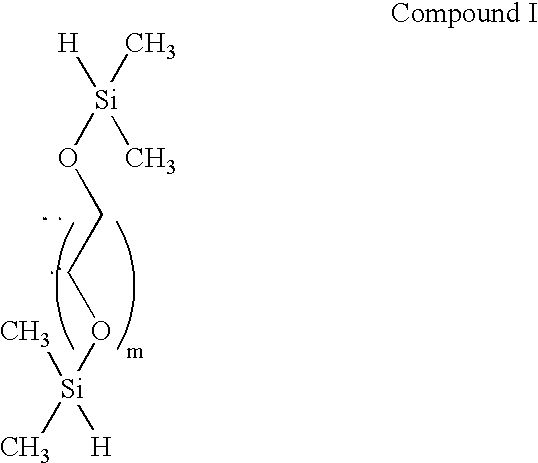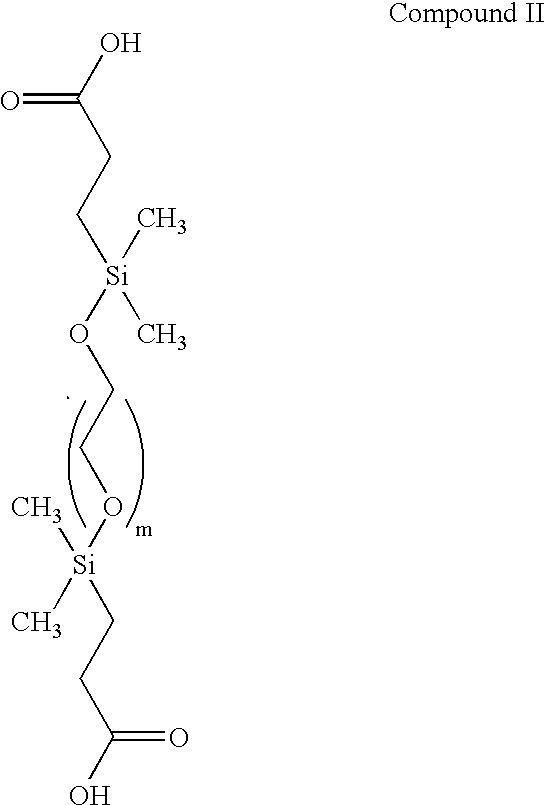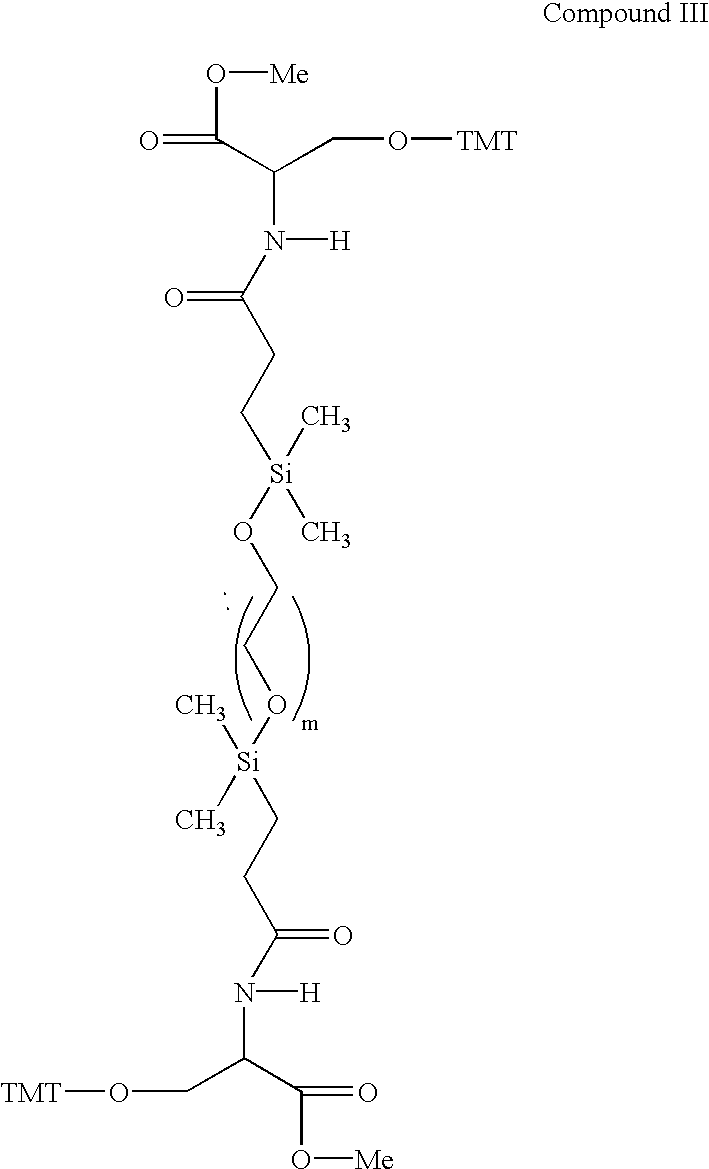Optical disk-based assay devices and methods
an optical disk and assay technology, applied in the field of analytical instruments, can solve the problems of centralized laboratories and large hospitals, the cost of analyzers is high, and the design limit of such efforts
- Summary
- Abstract
- Description
- Claims
- Application Information
AI Technical Summary
Benefits of technology
Problems solved by technology
Method used
Image
Examples
example 1
6.1 Example 1
Synthesis of a Spacer With Cleavable Siloxane Site
[0479] A representative cleavable spacer, shown schematically in FIG. 5, is synthesized as follows.
[0480] In brief, the synthesis is begun by constructing the central portion of the spacer molecule first. Both ends of the poly(ethyleneglycol) are then silanized, e.g. with chlorodimethylsilane to afford a compound of the formula of Compound I.
[0481] The silane groups then are derivatized with an alkenoic acid, straight or branched chain (e.g., CH.dbd.CH(CH.sub.2).sub.nCOOH, n=1-11, although the number of carbon atoms is immaterial, such as vinyl acetic acid, acrylic acid and the like) having a terminal double bond, such as vinyl acetic acid to form a compound having the structural formula of Compound II, and reacted further to provide a protected hydroxyl group on each side of the silane to provide for later attachment of oligonucleotides as illustrated by the compound having the structural formula of Compound III. Variou...
example 2
6.2 Example 2
Synthesis of a Cleavable Magnesium Dicarboxylate Spacer Recognizing Human IgG
[0503] Onto a gold-coated polycarbonate disk is added by ink-jet printer 2 .mu.l of 10 .mu.M biotindisulfide water solution in 64 circular spots having a diameter of 5 mm. Onto these same spots is added by ink-jet printer 2 .mu.l of a mixture of 1 .mu.M streptavidin and 1 .mu.M albumin.
[0504] Goat anti-human IgG (Bioprocessing, Inc., Scarborough, Me.; Covalent Immunology, Monroe, N.H.) is reduced by thioethanolamine to produce univalent halves, each of which consists of one heavy chain and one light chain (HL). Thioethanolamine is removed by dialysis and maleimido-polyethyleneglycol-biotin (MAL-PEG-BIO; MW 3,400, Shearwater Polymers, Inc., Alabama) is added. A small amount of thioethanolamine is added to render maleimido groups unreactive. The mixture is dialyzed against 10 mM phosphate buffer (pH 7) in a dialysis tube (molecular weight cut-off 30,000).
[0505] To this antibody derivative (Ab-PEG...
example 3
6.3 Example 3
Detection of HIV-1 in a Nucleic Acid Assay
[0512] HIV-1 proviral DNA from clinical samples is amplified as follows, essentially as described in U.S. Pat. No. 5,599,662, incorporated herein by reference.
[0513] Peripheral blood monocytes are isolated by standard Ficoll-Hypaque density gradient methods. Following isolation of the cells, the DNA is extracted as described in Butcher and Spadoro, Clin. Immunol. Newsletter 12:73-76 (1992), incorporated herein by reference.
[0514] Polymerase chain reaction is performed in a 100 .mu.l reaction volume, of which 50 .mu.l is contributed by the sample. The reaction contains the following reagents at the following initial concentrations:
[0515] 10 mM Tris-HCl (pH 8.4)
[0516] 50 mM KCl
[0517] 200 .mu.M each dATP, dCTP, dGTP, and dUTP
[0518] 25 pmoles of primer 1, of sequence shown below
[0519] 25 pmoles of primer 2, of sequence shown below
[0520] 3.0 mM MgCl.sub.2
[0521] 10% glycerol
[0522] 2.0 units of Taq DNA polymerase (Perkin-Elmer)
[0523] 2...
PUM
| Property | Measurement | Unit |
|---|---|---|
| diameter | aaaaa | aaaaa |
| diameter | aaaaa | aaaaa |
| Thickness | aaaaa | aaaaa |
Abstract
Description
Claims
Application Information
 Login to View More
Login to View More - R&D
- Intellectual Property
- Life Sciences
- Materials
- Tech Scout
- Unparalleled Data Quality
- Higher Quality Content
- 60% Fewer Hallucinations
Browse by: Latest US Patents, China's latest patents, Technical Efficacy Thesaurus, Application Domain, Technology Topic, Popular Technical Reports.
© 2025 PatSnap. All rights reserved.Legal|Privacy policy|Modern Slavery Act Transparency Statement|Sitemap|About US| Contact US: help@patsnap.com



